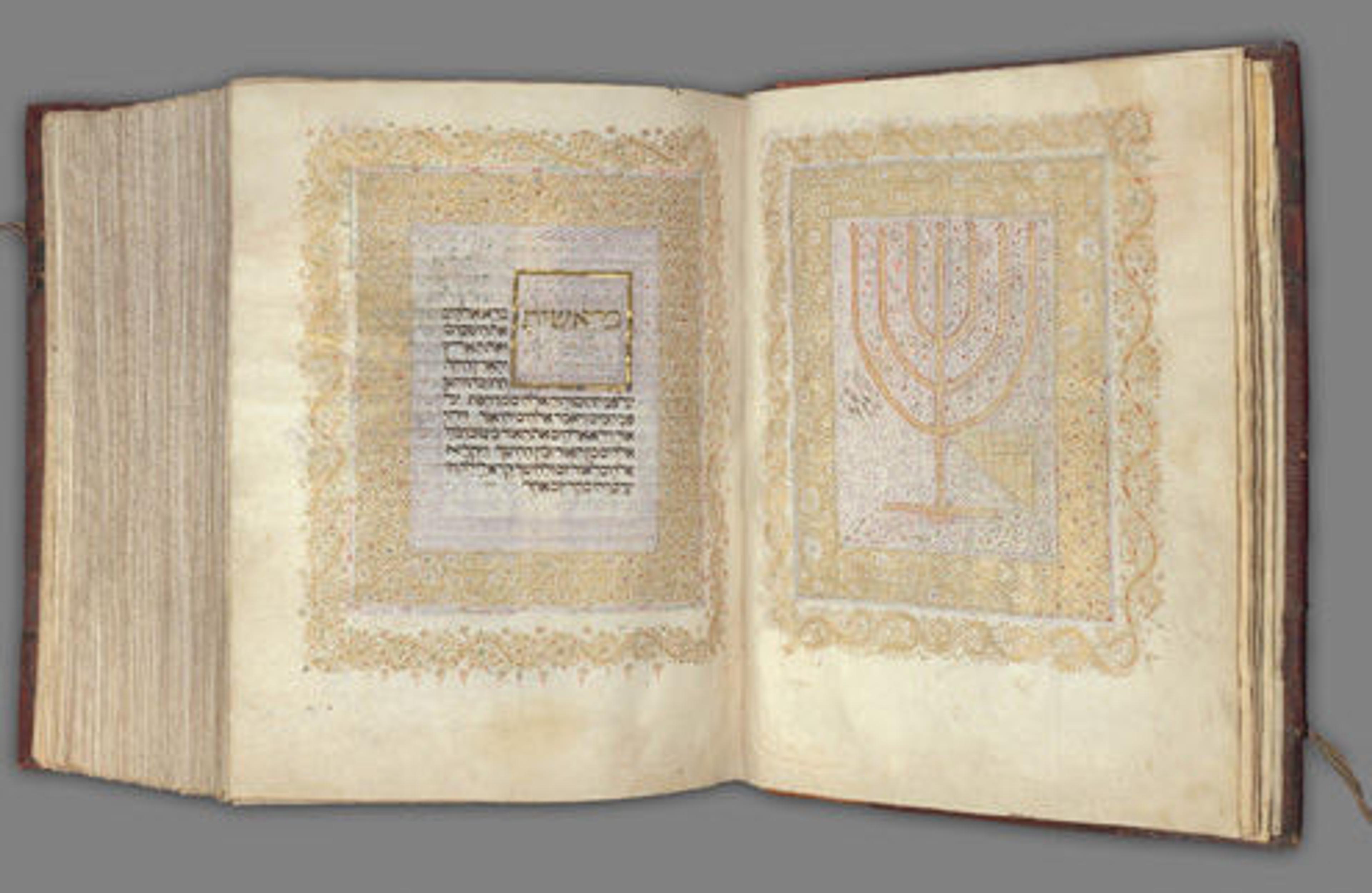
(New York, November 26, 2013)—On the occasion of Hanukkah—the Jewish Festival of Lights, celebrated this year from the evening of November 27 through the evening of December 5—two medieval depictions of the Temple menorah are on view at The Metropolitan Museum of Art. Additional works of Judaica will be on view during and after the holiday.
Images of Menorahs
The menorah, an elaborate ceremonial lamp with seven branches, was among the furnishings of the Temple in Jerusalem. Its form considered to be divinely ordained, the menorah has been a recognized symbol of Judaism from ancient times.
Two distinct visions of the menorah are on display in the Medieval Galleries. The first appears in a copy of the Mishneh Torah of Maimonides that is on loan from The Jewish Theological Seminary Library (Gallery 304). The Mishneh Torah, or “Repetition of the Law,” was the first systematic collection of Jewish law; it was made for an unknown, but clearly prosperous, Ashkenazi community in northern France or Germany around 1275 to 1350. Its artist used vibrant yellow, red, and blue hues to render the great candlestick. It conforms to Maimonides’ description of the design, with goblets, bulbs, and flowers forming the branches, as specified in the Torah.
The second image of the menorah that is on view at the Metropolitan Museum appears in a Hebrew Bible (Gallery 306). On loan from the Hispanic Society of America, this Bible contains the 24 books of the Jewish canon. It was written and decorated for a Sephardic community in Spain sometime around 1450 and a few years later taken to Portugal, where new pages in a different but complementary style were added. The pages currently on display, which depict the Temple menorah and the opening of the book of Genesis, showcase the resplendent filigree of the original decorative program.
Related Judaica
Another example of the Mishneh Torah—in this instance, a rare, beautifully illustrated 15th-century handwritten copy, recently acquired jointly by The Metropolitan Museum of Art and the Israel Museum in Jerusalem—will remain on view through January 5, 2014, also in The Lawrence A. and Barbara Fleischman Gallery of Late Medieval Secular Art (Gallery 307).
A splendid, recently acquired 18th-century silver and parcel gilt Torah crown from Venice is also on view nearby, in the galleries of the Department of European Sculpture and Decorative Arts (Gallery 508). This work is a testimony to the artistic virtuosity of goldsmiths in Venice. In synagogues, the scroll of the Torah—the first five books of the Hebrew Bible—is often decorated with a set of vestments and silver ornaments including a crown or finials, and a shield. The crown augments the Torah’s status as an object associated with royalty and speaks to the centrality of the Torah in Jewish life. The motifs depicted include ritual references such as priestly garments, a miniature temple, a menorah, and the Tablets of the Law, the latter engraved in Hebrew with the Ten Commandments. Such rich embellishment is indicative of the wealth and influential status of the Jewish congregation in the Venetian city state. The maker, Andrea Zambelli, is known to have made a wide range of ritual Judaica as well as religious silver for the local churches. A later inscription in Hebrew documents that this "crown of glory, and diadem of beauty" [Isaiah 28:5] was given by the philanthropist and president of the Jewish community in Padua, Gabriel Trieste, to his congregation in the mid-19th century.
On view as of December 3 in one of the Mary and Michael Jaharis Galleries (Gallery 300) will be three amulets—one gold (with a case) and two silver—on loan from the New York Public Library. Made in the 5th-6th century, they were discovered in Jewish tombs in Irbid, Jordan, in 1853 or ca. 1909. Soon after their discovery, the amulets were unrolled and inserted into protective frames for study. All three are inscribed, but only the inscriptions on the silver amulets can still be read. In Jewish Palestinian Aramaic, they call for the protection of “Marian daughter of Sarah” and her unborn child. Amulets were worn in the Early Byzantine world to ensure good health, especially during pregnancy, and protection from natural and supernatural dangers, including the evil eye.
Related Online Resources
Featured on the Museum’s Heilbrunn Timeline of Art History are two essays on Jewish art—“Jewish Art in Late Antiquity and Early Byzantium” and “Jews and the Arts in Medieval Europe”—written by Barbara Drake Boehm and Melanie Holcomb, of the Museum’s Department of Medieval Art and The Cloisters. Both curators have participated in the Institute in Jewish Art, a program of the Jewish Theological Seminary in New York. Relevant works in the Museum’s collection are listed, along with further readings and additional resources.
# # #
November 26, 2013